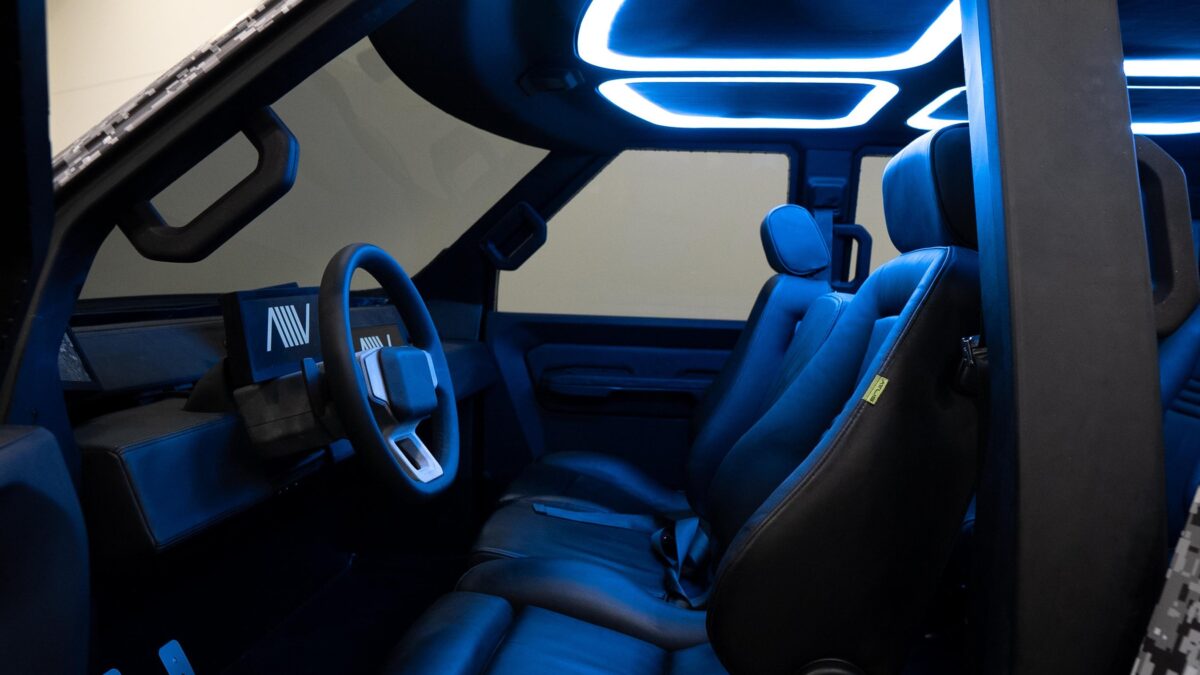Atlis Motor Vehicles is trying to disrupt the electric work truck market by developing its own chassis and the batteries and motors to drive it.
And it is taking a disruptive path to becoming a public company.
About 29,000 investors have purchased $32.6 million in private shares of the Mesa, Arizona-based company. Atlis holds the ticker symbol AMV on the Nasdaq Global Market. And that’s where the shares will trade when the listing is activated sometime in the next few months.

“Only a handful of companies have ever done this,” Mark Hanchett, founder and CEO, told FreightWaves. “You can think of it as a public offering of Atlis stock.”
The Nasdaq Global Market is one tier below the more exclusive Nasdaq Global Select Market, where companies must meet more stringent financial and liquidity requirements.
A mini-IPO
Sometimes called a “mini IPO” because the amounts raised pale in comparison to headline-grabbing initial public offerings, Atlis is using a mechanism called Regulation A financing, a federally regulated hybrid of a direct listing and an IPO.
From 2015 to 2020, about 250 companies raised an aggregate of $3 billion via Regulation A, according to Jay Kesten, associate professor of law at Florida State University.
“Companies can engage in these offerings when they want to raise a meaningful amount of money, but not enough to justify a full-blown IPO,” said Kesten, who follows corporate governance and securities regulation.
“It’s a middle ground between a private capital raise and a full-blown public offering, but with an important difference. Unlike private offerings, Reg A allows companies to issue freely tradable shares, creating a public market for the company’s stock.”
Reg A is a government-sanctioned form of fundraising capped at $50 million until it was raised to $75 million in 2021, Kesten said.
“The 2021 cap increase is likely to increase those figures significantly going forward,” he said.
The first Reg A companies listed on the New York Stock Exchange and the Nasdaq in 2017. And about a dozen followed. Meanwhile, hundreds have listed to trade over the counter (OTC).
Capital raising for small companies
Small and midsize companies rebuffed by venture capital got a boost when crowdfunding of up to $5 million a year from registered and individual investors became legal under Regulation CF in the 2015 Jobs Act.
Regs CF and A exempt private companies from some Securities and Exchange Commission requirements. Atlis, founded in 2016, sells shares on its website through a broker dealer, avoiding reams of paperwork and the tens of millions of dollars an IPO can cost.
“It’s incredibly inexpensive to do this,” Hanchett said. “It’s very straightforward. We go through the same checks and balances and everything else to be a public company. We have to meet all the requirements.”
Not a SPAC
Regulation A offerings bear little resemblance to special purpose acquisition companies, shell companies that seek to merge with startups, sometimes with limited understanding of the business being acquired. As promoters, SPAC sponsors can end up with as much as 20% equity of the merged company.
SPACs were all the rage in 2020 and 2021, attracting tens of billions from investors in the sponsoring companies.
Over time, public scandals and tighter SEC regulations cooled the market. Some institutional institutions and hedge funds that invested in private investment in public equity (PIPE) offerings, to augment sponsors’ IPOs, redeemed shares before the business combination closed. That meant startup companies received less money to fund their business plans.
“There is almost no capital that comes out of a SPAC,” Hanchett said. “But there’s a tremendous amount of cost. It’s in the tens of millions of dollars to complete that transaction.”
In the current bear market, most de-SPACed transportation startups trade in the single digits. Many will have to go back to the public markets to raise additional capital as electric truck maker Nikola Corp. is doing.
Why go public now?
That makes the obvious question for Hanchett the timing of going public.
“We are lining up a number of different capital-raising opportunities that we have to be public in order to facilitate,” he said. “We’ve got a strategy built out to raise about $2.2 billion on the public markets over the next several years.”
Atlis raised its first $1 million in 2018 by selling shares at 29 cents. With each successive round of crowdfunding, the price has risen. Early investors who held the stock qualified for bonus shares, an inducement similar to fractional warrants granted to SPAC investors to purchase shares at a set price.
The current Atlis Reg A offering sells for $15.88 a share and will close when it reaches $12 million. Sales in Atlis’ second and current Reg A tallied nearly $11 million from 6,210 investors as of Monday.
“This is something that any company could do, but it’s not something that most companies will do,” Hanchett said. “This is how we’ve built this company, how we’ve raised funding, how we’ve generated interest in the product and what we’re developing.”
History of Atlis Motor Vehicles crowdfunding from nearly 29,000 investors
| Year | Method | Share price | Amount | Investors |
| 2018 | Regulation CF1 | 29 cents | $1 million | 1,881 |
| 2019 | Regulation CF2 | $5.83 | $1 million | 1,175 |
| 2020 | Regulation A | $8.24 | $14.6 million | 15,323 |
| 2021 | Regulation CF3 | $12.74 | $ 5 million | 4,108 |
| 2022 (current) | Regulation A | $15.88 | $11 million* | 6,210 |
Sixth round will take Atlis public
Atlis announced May 4 that its third Reg A offering — effectively its sixth fundraising round — will be used to go public. If the business succeeds, early investors could sell their shares and pocket a tidy profit.
“If we fail, which we won’t, those investors would lose,” Hanchett said.
So, Atlis is using Google ads too target people who have looked at Atlis, beseeching them to “Invest in the future of work today” with a link to the Atlis website.
“We use multiple platforms to advertise our products and brand, as well as the investment opportunity,” said Mary Trout, Atlis director of marketing. “These platforms provide tools to track conversions and, based on the results, Atlis is confident in this ad strategy as a way to introduce the brand to future customers and investors alike.”
Cutting deals and generating revenue
Atlis is cutting numerous deals and generating revenue from some of its products. AMV claims its Cube Cell can charge from zero to 100% in 15 minutes and provide consistent performance in any environment. The stand-alone business unit has more than $300 million in battery cell and pack commitments, according to Atlis.
In another deal in February, Atlis signed a collaborative agreement with an undisclosed military supplier to convert Humvees into electric vehicles.The military supplier will use Atlis’ XP platform to design, develop and manufacture military-grade equipment for the U.S. military and foreign allies.

And last September, Atlis signed a contract with Australian Manufactured Vehicles to build 19,000 XT electric pickup trucks through 2025. Atlis claims the trucks can travel 500 miles on a single charge with the muscle to pull trailers and perform other work that passenger-oriented electric pickups cannot.
As a converter of General Motors, Ford and Ram pickups to right-hand drive, the Australian company is short of inventory as supply chain disruptions choke off truck production and exports. Most other battery-electric pickups don’t qualify as work trucks.
“The Tesla Cybertruck and the Rivian trucks don’t fit the market we’re targeting,” Hanchett said. “They are looking for a electric pickup truck that really, truly is dedicated to work.”
Related articles:
Nikola cuts deal for $200M through sale of senior debt
Embark Trucks concludes SPAC but bolting investors take back $300M
Plus money: autonomous technology startup adds $220M to recent capital raise











